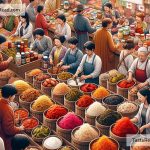Discovering the Magic of Traditional Chinese Dumplings
Ah, dumplings – the little pockets of joy that have been warming hearts and bellies for centuries. Originating from China, dumplings are not just food; they’re a cultural phenomenon, an art form, and for many, a nostalgic link to childhood memories. Today, we’ll dive into the fascinating world of traditional Chinese dumplings, exploring their varieties, meanings, and why they hold such a special place in Chinese culture.
The Variety Is Astounding
When you think of Chinese dumplings, you might imagine the typical steamed or fried pouches filled with meat and vegetables. But the term ‘dumpling’ covers a vast array of delightful treats, each unique to different regions and cultures within China.
First up, let’s talk about Jiaozi. These are perhaps what most people think of when they hear “dumplings.” Traditionally eaten during Chinese New Year to bring wealth and good fortune, Jiaozi are crescent-shaped and can be boiled, steamed, or pan-fried. The fillings vary widely, featuring combinations of pork, chicken, beef, shrimp, and vegetables.
Next, we have Xiaolongbao, or soup dumplings. Originating from Shanghai, these are steamed buns filled with a deliciously seasoned meat filling and, most impressively, rich, flavorful soup inside. Biting into a Xiaolongbao is an experience like no other, combining the pleasure of a dumpling and soup in one bite.
Another notable mention is Shumai, which hails from the Cantonese cuisine. These are open-top dumplings with a thin wrapper surrounding a filling of shrimp, pork, or both, often topped with an orange dot of crab roe or carrot. They’re a staple in dim sum and are steamed to perfection.
And let’s not forget about Wontons. Smaller than Jiaozi and often with a thinner wrapper, these are usually boiled and served in soup, though they can also be deep-fried. The fillings are similar to those of Jiaozi, but the presence of soup adds a comforting dimension.
The Cultural and Emotional Significance
Dumplings are more than just food; they’re a vessel for tradition and family bonding. The making of dumplings, particularly for the Chinese New Year, is a communal activity that brings families together. Everyone, from the youngest to the oldest, has a role in the preparation – from kneading the dough and preparing the fillings to the actual wrapping and cooking. This process is not just about making food; it’s about creating memories, sharing stories, and strengthening familial bonds.
Moreover, dumplings carry symbolic meanings in Chinese culture. For instance, Jiaozi are shaped like ancient Chinese gold ingots, symbolizing wealth and prosperity. Eating them during the New Year is believed to bring fortune and good luck for the coming year.
Why Dumplings Are Loved By Many
The universal appeal of dumplings can be attributed to their incredible versatility and the sheer joy of eating them. There’s a dumpling out there for everyone – whether you prefer them meaty, vegetarian, steamed, boiled, or fried. The experience of biting into a well-made dumpling, with its combination of textures and flavors, is genuinely delightful.
Furthermore, dumplings represent comfort food for many people. They’re often associated with home cooking, family gatherings, and festive celebrations. The act of eating dumplings can evoke feelings of warmth, nostalgia, and belonging.
In Conclusion
Traditional Chinese dumplings are a world of their own, offering an endless array of tastes, textures, and traditions. They are a testament to China’s rich culinary heritage and its emphasis on community and family. Whether you’re experienced in the art of dumpling-making or a newcomer eager to delve into this delicious aspect of Chinese cuisine, the journey is sure to be rewarding.
So next time you have the opportunity, why not try your hand at making some dumplings? Or perhaps visit a local Chinese restaurant to experience the joy of these little pockets of happiness. You might just find yourself falling in love with the magic of traditional Chinese dumplings.


